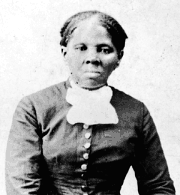Who is a hero? A hero is a person who might have sruggles but still is able to do what he or she has to do. A hero is a person who doesn't let their past bring them down. A hero is a person who doesn't look in their past to dictate their future. A hero to me is Harriet Tubman.
Harriet Tubman was born in the early 1820’s on a plantation in Dorchester County, Maryland. As a child she was beat frequently by her master. At night she would sleep close to the fire to keep warm and so her feet wouldn’t get frostbite. When Harriet was six she was sent to work but not in the fields. She was sent to work for a couple who were friends of her master. When she would slack on her work she was put to check on the muskrat trap. Harriet caught the measles from checking the muskrat trap. When Harriet got well she was sent to work for a woman doing housekeeping and babysitting. She was whipped by this lady all the time. Harriet was sent back to the plantation when she was caught eating a sugar cube.
 |
In 1849 Harriet Tubman escaped from the plantation. A white abolitionist man who lived next door gave her a piece of paper with two names on it. At the first house the man put her in a wagon covered with sacks and took her to her next place. The man who carried her in the wagon was kind enough to give her a name and the place she could go to get past the Mason-Dixon line. After passing the Mason-Dixon line, she hitched a ride with a woman and her husband who were passing through. They took Harriet to Philadelphia where she got a job and saved her pay to help free slaves. Harriet met a man named William Still who was one of the Underground Railroad's busiest masters.
 |
In September 1850, Harriet was made a conductor of the Underground Railroad. She was told all the free routes to take to free the slaves. After returning from her first trip, Harriet Tubman went back down south to rescue her brother and friends. In 1850, they passed the Fugitive Slave Act which said that if a slave was found trying to run away, they would be taken back to their owners. Harriet was very courageous because, despite the act, she still went back to get more slaves. Harriet had many rewards out for her because they said that she was not a free slave. They said that she needed to be returned to her owner.
Harriet Tubman was known as Moses. She was called Moses because she led the people to freedom just as Moses did in the Bible. Harriet went to Canada in 1851. She made many trips from Canada to the South to free people. The most famous trip was the one where a slave panicked and wanted to go back to the plantation, but Harriet pointed a gun to his head and said, "Dead folks tell no tales." This man changed his mind and wanted to go on.
Page created on 3/27/2006 12:00:00 AM
Last edited 3/27/2006 12:00:00 AM
